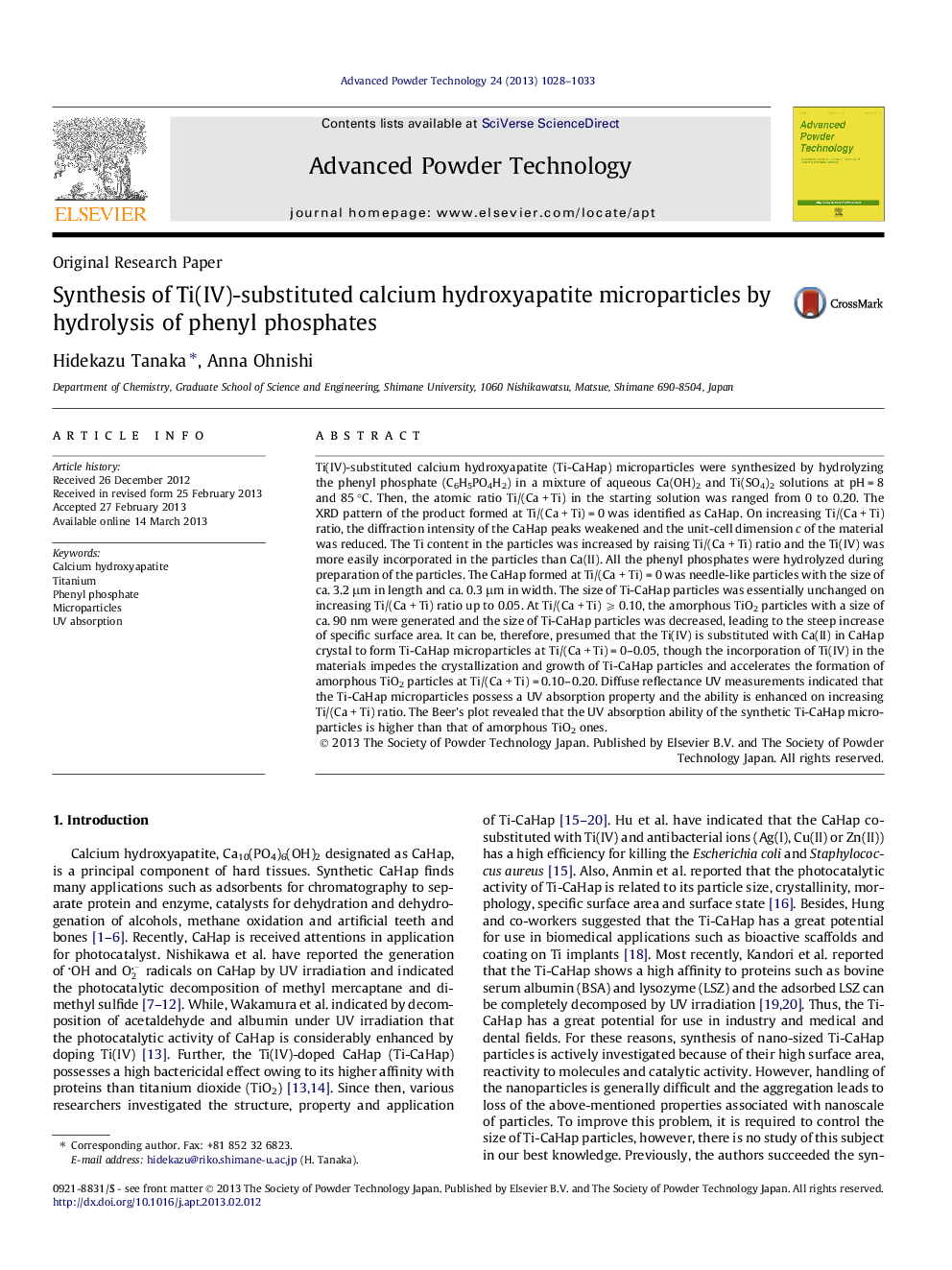| کد مقاله | کد نشریه | سال انتشار | مقاله انگلیسی | نسخه تمام متن |
|---|---|---|---|---|
| 144214 | 438924 | 2013 | 6 صفحه PDF | دانلود رایگان |

Highlight
• Ti(IV)-doped calcium hydroxyapatite (Ti-CaHap) microparticles were prepared by hydrolyzing phenyl phosphates.
• The Ti-CaHap particles were needle-like with a size of ca. 3.2 μm in length and ca. 0.3 μm in width.
• The Ti(IV) was more easily incorporated in the particles than Ca(II) and was substituted with Ca(II) in CaHap crystal.
• The Ti-CaHap microparticles showed a UV absorption property and the ability was enhanced by increasing the Ti contents.
Ti(IV)-substituted calcium hydroxyapatite (Ti-CaHap) microparticles were synthesized by hydrolyzing the phenyl phosphate (C6H5PO4H2) in a mixture of aqueous Ca(OH)2 and Ti(SO4)2 solutions at pH = 8 and 85 °C. Then, the atomic ratio Ti/(Ca + Ti) in the starting solution was ranged from 0 to 0.20. The XRD pattern of the product formed at Ti/(Ca + Ti) = 0 was identified as CaHap. On increasing Ti/(Ca + Ti) ratio, the diffraction intensity of the CaHap peaks weakened and the unit-cell dimension c of the material was reduced. The Ti content in the particles was increased by raising Ti/(Ca + Ti) ratio and the Ti(IV) was more easily incorporated in the particles than Ca(II). All the phenyl phosphates were hydrolyzed during preparation of the particles. The CaHap formed at Ti/(Ca + Ti) = 0 was needle-like particles with the size of ca. 3.2 μm in length and ca. 0.3 μm in width. The size of Ti-CaHap particles was essentially unchanged on increasing Ti/(Ca + Ti) ratio up to 0.05. At Ti/(Ca + Ti) ⩾ 0.10, the amorphous TiO2 particles with a size of ca. 90 nm were generated and the size of Ti-CaHap particles was decreased, leading to the steep increase of specific surface area. It can be, therefore, presumed that the Ti(IV) is substituted with Ca(II) in CaHap crystal to form Ti-CaHap microparticles at Ti/(Ca + Ti) = 0–0.05, though the incorporation of Ti(IV) in the materials impedes the crystallization and growth of Ti-CaHap particles and accelerates the formation of amorphous TiO2 particles at Ti/(Ca + Ti) = 0.10–0.20. Diffuse reflectance UV measurements indicated that the Ti-CaHap microparticles possess a UV absorption property and the ability is enhanced on increasing Ti/(Ca + Ti) ratio. The Beer’s plot revealed that the UV absorption ability of the synthetic Ti-CaHap microparticles is higher than that of amorphous TiO2 ones.
Diffuse reflectance UV spectrum and TEM picture of Ti-CaHap microparticles prepared using phenyl phosphates.Figure optionsDownload as PowerPoint slide
Journal: Advanced Powder Technology - Volume 24, Issue 6, November 2013, Pages 1028–1033